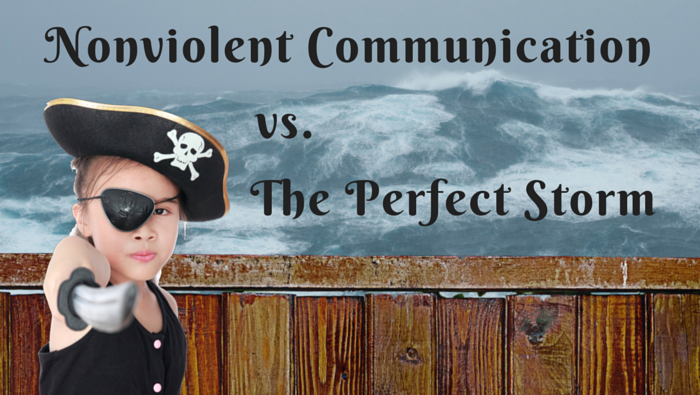![]()
My leadership blog is all about helping current and emerging leaders learn how to transform difficult conversations and dysfunctional workplace relationships into positive and productive ones.


NVC vs. The Perfect Storm
The Facts:
/
-
This is the second week of summer holidays for my kids, Finley (8) and Clara (5).
-
They’ll continue to be at home during the day until they start their day camps next Monday.
-
My wife works at an office downtown.
-
I work out of my home office.
/
The Result:
/
/
Since I started work this morning, I’ve been sitting here at the computer, struggling to even come up with a topic for this week’s blog post. It’s just one of those days when I’m having a hard time focusing my thoughts and I’ve been getting more and more frustrated.
/
My kids have a neighbourhood friend over and they’ve been having a good time playing together (loudly). Surprise, surprise — this isn’t helping my concentration.
/
They then all found their way up to my office, my kids excited to show their friend their secret hide-out, which happens to double as my storage closet. Their fun is now smack in the domain of my writer’s block and the decibels have spiked/even further.
/
And I just yelled at them, “Okay, that’s it! Go outside and play!” And they have.
Once my adrenalin/cortisol surge receded, the topic for this post came trotting up to me on the back of a most curious creature …
/
/
Ah, once again, my children have proved to be my greatest teachers.
RESOURCE:
<iframe style="width: 120px; height: 240px;" src="http://rcm-na.amazon-adsystem.com/e/cm?lt1=_blank&bc1=000000&IS2=1&npa=1&bg1=EEEEEE&fc1=000000&lc1=0000FF&t=connectconver-20&o=15&p=8&l=as4&m=amazon&f=ifr&ref=ss_til&asins=1592336337" width="300" height="150" frameborder="0" marginwidth="0" marginheight="0" scrolling="no"></iframe>
Have you ever shouted things out at work like:
/
“Just get back to work!”
“Don’t bother me right now!”
“Just get it done!”
“Keep it down out here!”
/
Outbursts like this never help anyone.
/
/
There are two things you can practice in situations at work when you’re starting to feel your frustration mounting and your blood boiling …
/
1. Emotional Intelligence
/
In particular, you need to be able to recognize your mounting frustration before you blow your top. Then take a breath and let the emotion evaporate as you exhale. You need to repeat this until you’re calm; then you’re ready for the next step.
RESOURCE:
<iframe style="width: 120px; height: 240px;" src="http://rcm-na.amazon-adsystem.com/e/cm?lt1=_blank&bc1=000000&IS2=1&npa=1&bg1=EEEEEE&fc1=000000&lc1=0000FF&t=connectconver-20&o=15&p=8&l=as1&m=amazon&f=ifr&ref=tf_til&asins=055338371X" width="300" height="150" frameborder="0" marginwidth="0" marginheight="0" scrolling="no"></iframe>
RESOURCE:
<iframe style="width: 120px; height: 240px;" src="http://rcm-na.amazon-adsystem.com/e/cm?lt1=_blank&bc1=000000&IS2=1&npa=1&bg1=EEEEEE&fc1=000000&lc1=0000FF&t=connectconver-20&o=15&p=8&l=as4&m=amazon&f=ifr&ref=ss_til&asins=0974320625" width="300" height="150" frameborder="0" marginwidth="0" marginheight="0" scrolling="no"></iframe>
2. Nonviolent Communication
/
Marshall Rosenberg developed the Nonviolent Communication (NVC) process in the 1960s.
/
Nonviolent Communication holds that most conflicts between individuals or groups arise from miscommunication about their human needs, due to coercive or manipulative language that aims to induce fear, guilt, shame, etc. These “violent” modes of communication, when used during a conflict, divert the attention of the participants away from clarifying their needs, their feelings, their perceptions, and their requests, thus perpetuating the conflict.” (Wikipedia)
RESOURCE:
<iframe style="width: 120px; height: 240px;" src="http://rcm-na.amazon-adsystem.com/e/cm?lt1=_blank&bc1=000000&IS2=1&npa=1&bg1=EEEEEE&fc1=000000&lc1=0000FF&t=connectconver-20&o=15&p=8&l=as4&m=amazon&f=ifr&ref=ss_til&asins=1892005034" width="300" height="150" frameborder="0" marginwidth="0" marginheight="0" scrolling="no"></iframe>
The NVC Process Has 4 Components:
/

/
Here’s an example of what this might sound like:
/
Observe:
/
“When I’m in my office with my door closed and I can hear you all talking out here …
/
Feelings:
/
“I start feeling frustrated and angry.”
/
Needs:
/
“When I really need to focus and concentrate on something, I need things to be quiet in order to get it done well and get it done on schedule.”
/
Requests:
/
“When my door is closed, would you all help me out and keep your conversations at a low volume?”
/
/
This approach works really well to avoid the kind of unnecessary conflict and hurt feelings that, from an organizational point of view, can dramatically reduce productivity.
/
Cultivating your emotional awareness and proficiency in NVC takes time and practice — and the benefits to all involved are well worth it.
/
Have a productive and enjoyable day!
/
— Brie
Blog Post

NVC vs. The Perfect Storm
The Facts:
/
-
This is the second week of summer holidays for my kids, Finley (8) and Clara (5).
-
They’ll continue to be at home during the day until they start their day camps next Monday.
-
My wife works at an office downtown.
-
I work out of my home office.
/
The Result:
/
/
Since I started work this morning, I’ve been sitting here at the computer, struggling to even come up with a topic for this week’s blog post. It’s just one of those days when I’m having a hard time focusing my thoughts and I’ve been getting more and more frustrated.
/
My kids have a neighbourhood friend over and they’ve been having a good time playing together (loudly). Surprise, surprise — this isn’t helping my concentration.
/
They then all found their way up to my office, my kids excited to show their friend their secret hide-out, which happens to double as my storage closet. Their fun is now smack in the domain of my writer’s block and the decibels have spiked/even further.
/
And I just yelled at them, “Okay, that’s it! Go outside and play!” And they have.
/
Once my adrenalin/cortisol surge receded, the topic for this post came trotting up to me on the back of a most curious creature …
/
/
Ah, once again, my children have proved to be my greatest teachers.
/
RESOURCE:
<iframe style="width: 120px; height: 240px;" src="http://rcm-na.amazon-adsystem.com/e/cm?lt1=_blank&bc1=000000&IS2=1&npa=1&bg1=EEEEEE&fc1=000000&lc1=0000FF&t=connectconver-20&o=15&p=8&l=as4&m=amazon&f=ifr&ref=ss_til&asins=1592336337" width="300" height="150" frameborder="0" marginwidth="0" marginheight="0" scrolling="no"></iframe>
Have you ever shouted things out at work like:
/
“Just get back to work!”
“Don’t bother me right now!”
“Just get it done!”
“Keep it down out here!”
/
Outbursts like this never help anyone.
/
/
There are two things you can practice in situations at work when you’re starting to feel your frustration mounting and your blood boiling …
/
/
1. Emotional Intelligence
/
In particular, you need to be able to recognize your mounting frustration before you blow your top. Then take a breath and let the emotion evaporate as you exhale. You need to repeat this until you’re calm; then you’re ready for the next step.
/
RESOURCES:
<iframe style="width: 120px; height: 240px;" src="http://rcm-na.amazon-adsystem.com/e/cm?lt1=_blank&bc1=000000&IS2=1&npa=1&bg1=EEEEEE&fc1=000000&lc1=0000FF&t=connectconver-20&o=15&p=8&l=as1&m=amazon&f=ifr&ref=tf_til&asins=055338371X" width="300" height="150" frameborder="0" marginwidth="0" marginheight="0" scrolling="no"></iframe>
<iframe style="width: 120px; height: 240px;" src="http://rcm-na.amazon-adsystem.com/e/cm?lt1=_blank&bc1=000000&IS2=1&npa=1&bg1=EEEEEE&fc1=000000&lc1=0000FF&t=connectconver-20&o=15&p=8&l=as4&m=amazon&f=ifr&ref=ss_til&asins=0974320625" width="300" height="150" frameborder="0" marginwidth="0" marginheight="0" scrolling="no"></iframe>
2. Nonviolent Communication
/
Marshall Rosenberg developed the Nonviolent Communication (NVC) process in the 1960s.
/
Nonviolent Communication holds that most conflicts between individuals or groups arise from miscommunication about their human needs, due to coercive or manipulative language that aims to induce fear, guilt, shame, etc. These “violent” modes of communication, when used during a conflict, divert the attention of the participants away from clarifying their needs, their feelings, their perceptions, and their requests, thus perpetuating the conflict.” (Wikipedia)
/
RESOURCE:
<iframe style="width: 120px; height: 240px;" src="http://rcm-na.amazon-adsystem.com/e/cm?lt1=_blank&bc1=000000&IS2=1&npa=1&bg1=EEEEEE&fc1=000000&lc1=0000FF&t=connectconver-20&o=15&p=8&l=as4&m=amazon&f=ifr&ref=ss_til&asins=1892005034" width="300" height="150" frameborder="0" marginwidth="0" marginheight="0" scrolling="no"></iframe>
The NVC Process Has 4 Components:
/

/
Here’s an example of what this might sound like:
/
Observe:
/
“When I’m in my office with my door closed and I can hear you all talking out here …
/
Feelings:
/
“I start feeling frustrated and angry.”
/
Needs:
/
“When I really need to focus and concentrate on something, I need things to be quiet in order to get it done well and get it done on schedule.”
/
Requests:
/
“When my door is closed, would you all help me out and keep your conversations at a low volume?”
/




